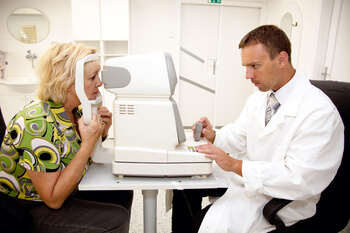
Laser Eye Correction — How Does This Treatment Work?
Laser eye correction is a type of operation that falls under refractive surgery. This group of procedures aims to provide a permanent, surgical form of vision correction in order to significantly reduce – or eliminate – your dependence on glasses and contact lenses. However, many people are a little apprehensive when it comes to procedures around the eyes, so learning more about laser eye surgery can help you to understand what you might be up for if you decide to go ahead. Here’s what you need to know about laser eye correction.
How Does Laser Eye Correction Work?
At the front of the eyeball is the cornea, a transparent dome of tissue. This is the first surface that’s responsible for bending light as it enters the eye. If the light isn’t bent or refracted to a degree that allows it to focus to a point on the retina at the back of the eye, you end up with a refractive error. Refractive errors include:
- Myopia (short-sightedness)
- Hyperopia (long-sightedness)
- Astigmatism (an uneven corneal or lens curvature)
Vision correction with laser eye surgery uses a laser tool to adjust the curvature of the cornea. By modifying the corneal shape, the refraction of light through this structure can be adjusted so that light can focus clearly on the retina, thereby providing sharp sight.
Types of Laser Eye Surgery
There are a number of different types of laser eye correction, each with its own pros and cons. Ultimately, your surgeon will help you to decide which technique is the most suitable for you. This will be based on several factors, including:
- The amount of corneal thickness available to work with
- Your lifestyle factors and occupation
- Your overall ocular health, including the presence of dry eyes
- Your prescription
In some cases, you may be considered unsuitable for any type of laser eye surgery. If this is so, your surgeon may still offer surgical vision correction with an entirely different refractive technique that’s not considered laser eye surgery.
There are three main methods of laser eye surgery.
- LASIK. This stands for laser-assisted in situ keratomileusis. During LASIK, a hinged flap is created out of the top layers of corneal tissue. By opening up this flap, a laser can be used to remove selected areas of deeper corneal cells to adjust its overall shape. Afterwards, the flap is repositioned. LASIK can be offered to patients with myopia, hyperopia, and astigmatism.
- PRK. Photorefractive keratectomy is an older form of surgical vision correction compared to LASIK but still retains its value, particularly for patients who have thin corneas unsuitable for LASIK vision correction. Though PRK also involves using a laser to reshape the cornea, it doesn’t require the creation of a flap, which takes up some of the available corneal thickness. Instead, only the top layer of cells, the epithelium, is removed and later regenerates during the recovery period. PRK is suitable for patients with myopia, hyperopia, and astigmatism.
- SMILE. This is the newest technique of laser eye surgery, first introduced in 2007. Without disrupting the outer cornea, whether through removing the epithelium or creating a flap, a laser can be used to reshape the deeper layers. Small incision lenticule extraction achieves this by creating a precisely shaped lenticule (a small disc) of the inner corneal tissues, which is then extracted from the eye through a keyhole incision. Removing this piece of tissue adjusts the overall corneal curvature. Currently, SMILE laser eye surgery is suitable for patients with myopia and astigmatism but not hyperopia.
Is Laser Vision Correction Permanent?
Laser vision correction is a permanent procedure in the way that it cannot be reversed once performed. However, there can be factors that cause your sight to deteriorate after having a successful operation.
The eye can still be subject to various diseases, infections, or trauma, which can affect your sight. For example, your sight might be sharp after having had laser vision correction, but if you develop cataracts or a corneal infection and scarring, you can expect your vision to become impaired.
However, around the mid-40s is when you might start to find that your clarity for reading begins to decline, even though your distance sight is still sharp. As presbyopia progresses, you will likely need to return to glasses or contacts to allow you to read.
One of the biggest issues for laser eye correction surgeons is regression. Regression refers to the slow return of the original prescription, though often not to the full degree. This means that an eye that was previously myopic, then successfully corrected with laser eye surgery, finds itself becoming myopic again.
Doctors still don’t fully understand why regression occurs or what steps can be taken to prevent it; one theory is that the healing response from the cornea over time results in the return of the original refractive error. Many people who experience regression can still access an enhancement or touch-up procedure to correct the sight again, but this depends on the amount of corneal thickness remaining from the first laser eye correction procedure.
Undergoing laser vision correction can be both exciting and daunting. If interested, contact your ophthalmologist on (03) 9070 5788 for a comprehensive examination to ensure your eyes are suitable for Laser Eye Surgery in Melbourne.
Note: Any surgical or invasive procedure carries risks. Before proceeding, you should seek a second opinion from an appropriately qualified health practitioner.
References
History and Results; Indications and Contraindications of SMILE Compared With LASIK.
https://www.ncbi.nlm.nih.gov/pmc/articles/PMC6784775/#:~:text=Introduced%20in%202007%2C%20SMILE%20has,less%20dry%20eye%20after%20SMILE.
Mechanisms of Optical Regression Following Corneal laser Refractive Surgery: Epithelial and Stromal Responses.
https://www.ncbi.nlm.nih.gov/pmc/articles/PMC5887600/






